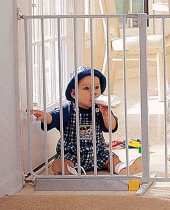Child Safety

WELCOME TO THE ALL 4 KIDS UK CHILD SAFETY PAGE. BELOW YOU'LL FIND HELPFUL TIPS AND ADVICE
Avoid the Worst. Put Child Safety First.
This year's theme for Child Safety Week recognises how busy parents are juggling their personal and professional lives and that sometimes it is all too easy to overlook child safety until the worst happens hence the heading Avoid the Worst. Put Child Safety First.
It is scary to think of your child stopping breathing and hopefully it will never happen, but what if it did; would you know how to resuscitate your child? Or how to dislodge something stuck in her throat? Just as important, would the person looking after your child know what to do? It’s a tough call and hopefully one that as a parent you will never have to deal with. Much more common though are the smaller incidents which happen. Over a million children every year visit an A & E department following an accident in the home and more than half of these children are under four. It is impossible to watch your child 24/7 and there will always be an unguarded moment but knowing what to do if an accident occurs can stop a minor incident turning into something much more serious. Amy Dopson, a first-aid trainer and paediatric senior sister in a Surrey hospital believes that parents need to familiarise themselves with what to do if a child has a burn, because immediate action can make a big difference to the outcome. “If parents know what to do when a child burns or scalds itself, we would have far less need for skin grafts and plastic surgery,” she says.
The Child Accident Prevention Trust (www.capt.org.uk) list their top four accidental injuries in the home as: Falls, which account for almost 25 % of all home accidental injuries to children and are the most common single cause of home accidental injury. Striking or collisions - these have the same injury rates for both the younger children (birth to 5) and for older children (ages 5 to 14). Burns and Scalds, which affect babies and toddlers three times more frequently than children over 5. Scalds from hot drinks are the most common cause and Poisoning, when children eat or drink medicines, household cleaners and chemicals, DIY and gardening substances. Over 90% of children accidentally poisoned in the home are under 4. Learning basic life saving skills and essential first aid could save your child's life. First Aid is not rocket science; the hardest bit is making the time to book onto a course.
For more information about first aid courses in your home please call 0208 449 8722 Or email info@safeandsound.uk.net. Web: www.safeandsound.uk.net.
5 Common First Aid Misconceptions
1. Burns "Put butter/antiseptic cream on it". NEVER put butter/antiseptic cream on a burn. Instead, cool the burn under cool running water for at least ten minutes to stop the burning and relieve the pain. If cold water is not available, use another cold, harmless liquid such as milk. Apply a non-fluffy dressing.
2. Nose Bleeds "Hold the child's head back and pinch the bridge of the nose" Treat nose bleeds by sitting the child down with the head tilted forward and pinch the fleshy part of the nostrils together for 10 minutes. Remember to tell the child to breathe through the mouth and spit any blood into a bowl or tissue.
3. Poisoning "Make the child vomit" NEVER induce vomiting - it could burn or block the airway. Try to find out what has been swallowed and how much and seek professional medical advice.
4. Choking "Stick your fingers down the child's throat" NEVER stick your fingers down a child's throat - you could cause further obstruction or cause the airway to swell. Start by bending the child forward from the waist and give 5 sharp back blows between the shoulder blades, using the heel of your hand.*
5. Epilepsy "Put something in the child's mouth for them to bite on" NEVER put anything in the mouth of a child during a seizure. Your priority is to keep the child safe until professional medical help arrives. Move furniture or any other obstructions out of the way. Keep calm, so that you can reassure and comfort the child.

























